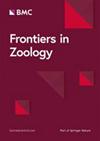人类活动重塑了华北豹与其野生猎物之间的空间重叠关系
IF 2.6
2区 生物学
Q1 ZOOLOGY
引用次数: 0
摘要
快速扩张的人类活动深刻地改变了大型食肉动物及其猎物对栖息地的利用,但人类活动是否以及如何影响它们之间的相互作用却相对较少受到关注。在本研究中,我们对华北中部太行山地区的濒危大型食肉动物(华北豹)及其野生猎物(西伯利亚狍和野猪)进行了系统设计的相机诱捕调查。根据大量取样工作(102 个取样点,15654 个照相日)获得的数据,我们使用条件双物种占据模型,研究了在人类存在、放养牛群、道路和定居点的影响下,豹和每种猎物之间的空间利用关系。人类和牛群对豹子与狍子之间空间利用关系的影响截然不同,在人类和牛群频繁活动的地点,豹子与狍子之间的空间隔离度分别较高和较低。道路可能为野猪提供了躲避金钱豹捕食的庇护所,在靠近道路的地点,野猪与金钱豹之间的空间隔离较小。我们的研究结果表明,人类活动正在重塑大型食肉动物与其猎物之间的空间重叠,并且对不同类型的人类活动产生了不等同的影响。这种影响可能会进一步改变捕食者与猎物之间种间相互作用的强度,对群落和生态系统产生深远的影响,需要进行更多的研究。本文章由计算机程序翻译,如有差异,请以英文原文为准。
Human activities reshape the spatial overlap between North Chinese leopard and its wild ungulate prey
Rapidly expanding human activities have profoundly changed the habitat use of both large carnivores and their prey, but whether and how human activities affect the interactions between them has received relatively less attention. In this study, we conducted a systematically designed camera-trapping survey on an endangered large carnivore (North Chinese leopard Panthera pardus japonensis) and its wild ungulate prey (Siberian roe deer Capreolus pygargus and wild boar Sus scrofa) in the Taihang Mountains of central North China. Using conditional two-species occupancy model based on data derived from the extensive sampling effort (15,654 camera-days at 102 camera sites), we examined the relationship of spatial use between leopards and each prey species under the effects of human presence, free-ranging cattle, roads and settlements. Humans and cattle had contrasting effects on the relationship of spatial use between leopard and roe deer, with higher and lower spatial segregation between them at human and cattle-frequented sites, respectively. Roads might create a shelter for wild boar from leopard predation, with less spatial segregation between them at sites close to the roads. Our findings demonstrate that human activities are reshaping the spatial overlap between large carnivores and their prey, and have non-equivalent effects among different types of human activity. Such effects may further alter the strength of interspecific interactions between predator and prey, with far-reaching influences on the community and ecosystem that require more research.
求助全文
通过发布文献求助,成功后即可免费获取论文全文。
去求助
来源期刊

Frontiers in Zoology
ZOOLOGY-
CiteScore
4.90
自引率
0.00%
发文量
29
审稿时长
>12 weeks
期刊介绍:
Frontiers in Zoology is an open access, peer-reviewed online journal publishing high quality research articles and reviews on all aspects of animal life.
As a biological discipline, zoology has one of the longest histories. Today it occasionally appears as though, due to the rapid expansion of life sciences, zoology has been replaced by more or less independent sub-disciplines amongst which exchange is often sparse. However, the recent advance of molecular methodology into "classical" fields of biology, and the development of theories that can explain phenomena on different levels of organisation, has led to a re-integration of zoological disciplines promoting a broader than usual approach to zoological questions. Zoology has re-emerged as an integrative discipline encompassing the most diverse aspects of animal life, from the level of the gene to the level of the ecosystem.
Frontiers in Zoology is the first open access journal focusing on zoology as a whole. It aims to represent and re-unite the various disciplines that look at animal life from different perspectives and at providing the basis for a comprehensive understanding of zoological phenomena on all levels of analysis. Frontiers in Zoology provides a unique opportunity to publish high quality research and reviews on zoological issues that will be internationally accessible to any reader at no cost.
The journal was initiated and is supported by the Deutsche Zoologische Gesellschaft, one of the largest national zoological societies with more than a century-long tradition in promoting high-level zoological research.
 求助内容:
求助内容: 应助结果提醒方式:
应助结果提醒方式:


